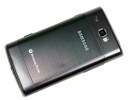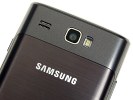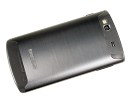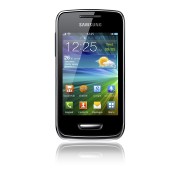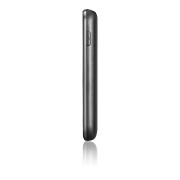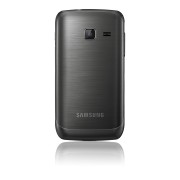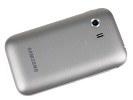Samsung announces Omnia W, we go hands-on
Windows phone 7 Mango update is coming any moment now and so are the first phones that will have it stock right out of the box. HTC has already announced the Mango-based Titan and Radar, so today is the Samsung's turn - meet the Omnia W.The Omnia W packs a 3.7-inch WVGA Super AMOLED screen and is based on the Qualcomm MSM8255 Snapdragon chipset with a 1.4GHz Scorpion processor, Adreno 205 graphics and 512MB RAM. Since Microsoft has strict policy about the hardware there is very little space Samsung to innovate.The rest of the specs are pretty much standard - a 5 megapixel snapper with a LED flash, a 720p camcorder, a front-facing VGA camera, 8GB internal storage, a 1500mAh battery and the usual connectivity (Wi-Fi, GPS, Bluetooth).Samsung Omnia W runs on the latest Windows Phone 7 Mango version and there are just few Samsung apps you can download for free to get something unique with your phone, since Microsoft forbids customizations.According to GSMInfo.nl the Omnia W is expected this November for about €450 for the unlocked device.We also got a chance to play around with the Omnia W. It's nicely compact and not too heavy. The battery cover is made out of brushed metal (a nice touch!) but the rest of the body is plastic. Still, the Omnia W feels solidly built.On the front, there's the 3.7" SuperAMOLED screen with WVGA resolution. Below that is the Windows key flanked by capacitive back and search keys. There's a half-pressable shutter key on the side as it's customary for Windows Phones.Unfortunately, the phone had a rather bad case of a dead battery, so we can’t share any impressions about actually using the phone. We bet, however, it won't be long before we get one-on-one with the Omnia W again.Samsung Brings HD to the Galaxy: Samsung Galaxy S2 HD
Samsung already produces some pretty stunning smartphone displays but they’ve just upped the ante in Korea by announcing the Samsung Galaxy S2 HD. The Galaxy S2 HD shares almost identical specs as the Galaxy S2 LTE already announced for the region – including a 1.5GHz dual core processor, 8MP camera, and NFC chip – but sports a 4.65-inch HD screen with 720 x 1260 pixel resolution.The S2 HD will be available on all of Korea’s major carriers but international availability hasn’t been announced. That may leave some of you with a tingly feeling of emptiness in your belly that even a full pack of Tums can’t patch up but don’t worry… we’re thinking Samsung will bring their Chicken Soup for the HD smartphone display soul across the pond in the near future. And if not, maybe pick up your current smartphone and rub sone ‘Tussen on it.
The Galaxy S2 HD shares almost identical specs as the Galaxy S2 LTE already announced for the region – including a 1.5GHz dual core processor, 8MP camera, and NFC chip – but sports a 4.65-inch HD screen with 720 x 1260 pixel resolution.The S2 HD will be available on all of Korea’s major carriers but international availability hasn’t been announced. That may leave some of you with a tingly feeling of emptiness in your belly that even a full pack of Tums can’t patch up but don’t worry… we’re thinking Samsung will bring their Chicken Soup for the HD smartphone display soul across the pond in the near future. And if not, maybe pick up your current smartphone and rub sone ‘Tussen on it.
Samsung has shown off the Galaxy Note at IFA 2011, a huge 5.3-inch HD Super AMOLED handset which comes complete with a stylus called the S Pen.We grabbed some time with it on the show floor just after Samsung's press conference took place.he Note has a 1.4GHz ARM-based dual-core processor inside, though we have to be honest and say that while some apps were snappy, there was a bit of lag when dropping into things like the web browser. That surprised us as we'd assume the units we saw on the stand were shipping models. And it's doubly surprising given the Note's speedy processor. The 5.3-inch screen is WXGA resolution (1,280x800) and, as we've come to expect from Samsung's OLED screens, everything is super bright and colours stand out brilliantly - even though it is the largest such display ever fitted to a mobile device. More on how video looks a bit later.The cited 180 degree viewing angle is indeed in evidence - well, maybe not quite 180, but pretty darn close.The Samsung Galaxy Note screen delivers 285ppi - the iPhone 4 delivers 326ppi according to Apple. By comparison, the Samsung Galaxy S2 delivers 218ppi, and the older Galaxy S 233ppi..
The 5.3-inch screen is WXGA resolution (1,280x800) and, as we've come to expect from Samsung's OLED screens, everything is super bright and colours stand out brilliantly - even though it is the largest such display ever fitted to a mobile device. More on how video looks a bit later.The cited 180 degree viewing angle is indeed in evidence - well, maybe not quite 180, but pretty darn close.The Samsung Galaxy Note screen delivers 285ppi - the iPhone 4 delivers 326ppi according to Apple. By comparison, the Samsung Galaxy S2 delivers 218ppi, and the older Galaxy S 233ppi.. The Galaxy Note comes running Android 2.3 Gingerbread and boasts an 8MP camera with LED flash on the rear and a 2MP snapper up front (which you can see above). The Note can record Full 1080p HD video as well as stills and is fast and responsive at taking snaps.In the hand, the handset (if you can call it that) feels like a huge slab. But it really is thin, like the Galaxy S2 - though it's slightly thicker at 9.65mm.
The Galaxy Note comes running Android 2.3 Gingerbread and boasts an 8MP camera with LED flash on the rear and a 2MP snapper up front (which you can see above). The Note can record Full 1080p HD video as well as stills and is fast and responsive at taking snaps.In the hand, the handset (if you can call it that) feels like a huge slab. But it really is thin, like the Galaxy S2 - though it's slightly thicker at 9.65mm. And there's no getting away from the fact it looks really stupid when held up to your ear. Just look at Samusng's DJ Lee from the launch this morning for evidence.
And there's no getting away from the fact it looks really stupid when held up to your ear. Just look at Samusng's DJ Lee from the launch this morning for evidence. Indeed, you can see just how large the handset is from our pics of the end of the Note below.
Indeed, you can see just how large the handset is from our pics of the end of the Note below.- Check out Samsung Galaxy Note: what you need to know
As you can see, it really is a sizeable piece of kit - and no, we haven't got micro-hands. The top has the predictable 3.5mm headphone jack. ...while the bottom includes a similar-looking hole for a stylus (more on that in a mo) as well as the charging port. Despite the thickness, the battery is a 2,500mAh unit - that's nearly twice as big as a typical smartphone battery pack. Quite incredible. Mind you, you'll need a lot of power to drive that screen.
...while the bottom includes a similar-looking hole for a stylus (more on that in a mo) as well as the charging port. Despite the thickness, the battery is a 2,500mAh unit - that's nearly twice as big as a typical smartphone battery pack. Quite incredible. Mind you, you'll need a lot of power to drive that screen. Rounding out the key stats, the device comes with 16GB or 32GB of internal storage, and networking support includes HSPA+ for high-speed 3G and 802.11a/b/g/n Wi-Fi. If you're in the US, you'll get 4G LTE support too.The Samsung Galaxy Note includes a stylus called the S Pen. As we found out when having a play, it's pressure-sensitive so you can write on the screen as well as launch apps, take photos and more. It's like 1998 all over again. The Note also supports Samsung's new ChatON communication service.
Rounding out the key stats, the device comes with 16GB or 32GB of internal storage, and networking support includes HSPA+ for high-speed 3G and 802.11a/b/g/n Wi-Fi. If you're in the US, you'll get 4G LTE support too.The Samsung Galaxy Note includes a stylus called the S Pen. As we found out when having a play, it's pressure-sensitive so you can write on the screen as well as launch apps, take photos and more. It's like 1998 all over again. The Note also supports Samsung's new ChatON communication service.
 As you can see, it slots into the bottom of the device. Having the stylus is a nice luxury, but with Android and TouchWiz being so good with touch, we're not sure whether we'd actually use it that much.
As you can see, it slots into the bottom of the device. Having the stylus is a nice luxury, but with Android and TouchWiz being so good with touch, we're not sure whether we'd actually use it that much.









Samsung Galaxy S II US event LIVE COVERAGE
The Samsung event, which will see the announcement of the US Galaxy S II versions is just about to start and we are covering it live for you. Stay tuned and keep an eye on this article as it evolves, bringing you the latest news of the Galaxy S expansion on the other side of the big pond.We are already on site as the event is just about to kick off.
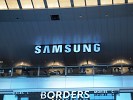



Three of the four major US carriers got a piece of the action with Verizon being left out in the cold. This could either mean that the Big Red will be focusing on the next iPhone or that it will be skipping the Galaxy S II and will be moving straight to the Ice Cream sandwich droids.
Now check out what the new announcements are all about.
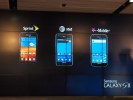


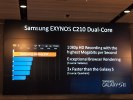
Samsung Galaxy S II (AT&T)
The AT&T version of the Galaxy S II won't have a name of its own. It goes by Samsung Galaxy S II, just like the international version of the smartphone and will basically be carrying the same hardware.
Samsung Galaxy S II for AT&T
The only hardware differences are in the exterior, most notably the controls at the front, where four touch-sensitive keys have replaced the two touch keys and a regular button combo. On the inside you are getting HSPA+ connectivity and the same Exynos chipset as the original Galaxy S II.

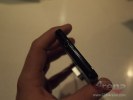
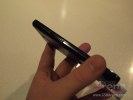
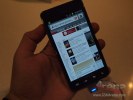
Samsung Galaxy S II for AT&T live photos
The Super AMOLED Plus screen stands at the same 4.3", and the TouchWiz-skinned Android 2.3.4 is also a part of the standard equipment.
At this stage we didn't get any details about the AT&T-bound Galaxy S II pricing or availability.
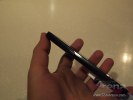
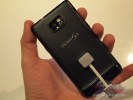
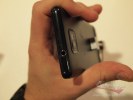
Samsung Galaxy S II for AT&T live photos
Samsung Galaxy S II (T-Mobile)
The T-Mobile Galaxy S II will come with a pretty big difference compared to the international version. It will be carrying a 4.52" Super AMOLED Plus, which is no minor difference.
Samsung Galaxy S II for T-Mobile
In fact the difference from 4.3" to 4.52" is quite noticeable even if you don't put the handsets side by side. The Galaxy S II versions with the smaller screens seem much easier to handle, though.
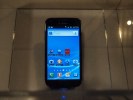
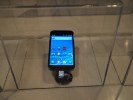
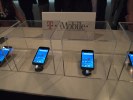
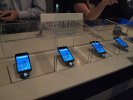
Samsung Galaxy S II for T-Mobile live photos
T-Mobile failed to mention anything about expected availability or pricing of their Galaxy S II, too.
Samsung Galaxy S II Epic 4G Touch (Sprint)
The Galaxy S II edition for the Sprint network is probably the most interesting of the bunch. Not only does it have a unique name, but it also has WiMax connectivity and the same larger 4.52” Super AMOLED Plus screen as the T-Mobile version.


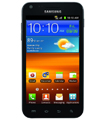

Samsung Galaxy S II Epic 4G Touch for Sprint
The Samsung Galaxy S II Epic 4G Touch will also feature a larger battery - 1800 mAh vs 1650 mAh for the AT&T and international Galaxy S II varieties. The price you have to pay is a slightly thicker shell, but we didn't find that to make such big difference when we handled the phone.
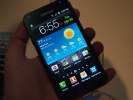
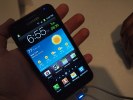
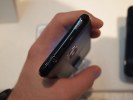
Samsung Galaxy S II Epic 4G Touch for Sprint
This will also be the first edition of the Samsung flagship smartphone to actually become available in the states. The Epic 4G Touch will be hitting Sprint stores starting on September 16th for $200 on a contract.
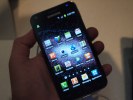
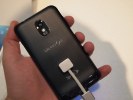
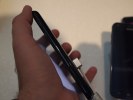
Samsung Galaxy S II Epic 4G Touch for Sprint
Samsung announces Wave 3, Wave M, and Wave Y Bada 2.0 trio
The long wait of all the fans of Samsung's Bada OS for a new device is finally over as today, Samsung announced a trio of Bada 2.0 phones, with Wave 3 being the new flagship for the company's proprietary OS. The devices also employ Samsung's new naming strategy, which we told you about recently.
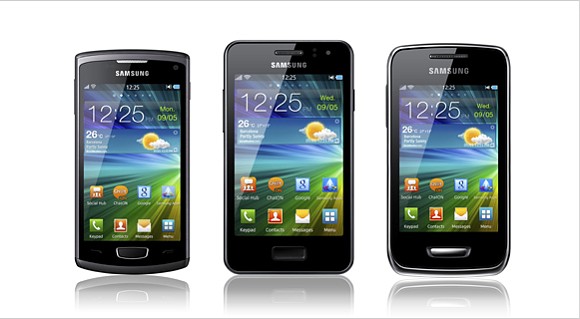
Like we mentioned above, the Wave 3 is the most feature packed phone of the bunch. It runs on a 1.4GHz CPU, and packs a 4" Super AMOLED screen with WVGA resolution, showing you Samsung's latest TouchWiz UI. There is a zippy HSDPA network connectivity on board, along with quad-band GPRS/EDGE. A 5MP auto focus camera with LED flash is in charge of taking photos and shooting HD videos (720p@30fps), while a VGA unit at the front will help you with video calls.
There is 3GB of built in memory in the Wave 3, and a microSD memory card slot (up to 32GB). Wi-Fi, Bluetooth 3.0, and USB 2.0 complete the connectivity package. There is accelerometer, proximity, and light sensors on board too, along with a compass. All this functionality will be powered by a 1500 mAh battery, and packed in a brushed aluminum body, weighing 122 grams.
And since we got the chance to get our hands on a Samsung S8600 Wave 3 unit (in fact we got all three of the new announcements), here come a few live photos for you to enjoy. Expect our exclusive preview of the latest Bada flagship to appear on our homepage later today.
The Samsung Wave M is the mid-range device from the trio, with a knack for social networking. It is powered by an 832 MHz CPU, and has a 3.65" TFT LCD screen with HVGA resolution. Like the Wave 3, the Wave M offers a 5MP AF camera on its back. Its video recording however has been limited to HVGA@30fps. A VGA front camera is present as well.
There is 150MB of built-in memory in the Wave M, and support for microSD cards (up to 32GB). A full connectivity package can be found on the device as well, along with an accelerometer and proximity sensor. The Wave M has a 1350 mAh battery under its metallic body. The device weighs 121 grams.
And here go the live shots of the Samsung Wave M S7250.
The Samsung Wave Y, as its name suggests, is the entry level phone in this Bada OS trio. It features the same CPU as its bigger brother, the Wave M, but has a smaller 3.2" TFT LCD screen with HVGA resolution.
The camera of the Wave Y is a 2MP fixed focus unit, capable of recording HVGA videos @30fps. Again, you will find 150 MB of built-in memory, along with microSD card support (up to 32GB). Quite logically, there is a full connectivity suite on board as well. The Wave Y is powered by a 1200 mAh battery. Its metallic body weighs a meager 102.4 grams.
The live shots of the last Bada smartphone to be announced today follow.
All three devices will have NFC capability as an option, along with Samsung's proprietary ChatON, Media Hub, and Kies services. The Bada 2.0 trio will be featured at the IFC, which begins this week in Berlin. Hopefully, we will find out about their pricing and availability there.
The long wait of all the fans of Samsung's Bada OS for a new device is finally over as today, Samsung announced a trio of Bada 2.0 phones, with Wave 3 being the new flagship for the company's proprietary OS. The devices also employ Samsung's new naming strategy, which we told you about recently.

Like we mentioned above, the Wave 3 is the most feature packed phone of the bunch. It runs on a 1.4GHz CPU, and packs a 4" Super AMOLED screen with WVGA resolution, showing you Samsung's latest TouchWiz UI. There is a zippy HSDPA network connectivity on board, along with quad-band GPRS/EDGE. A 5MP auto focus camera with LED flash is in charge of taking photos and shooting HD videos (720p@30fps), while a VGA unit at the front will help you with video calls.
There is 3GB of built in memory in the Wave 3, and a microSD memory card slot (up to 32GB). Wi-Fi, Bluetooth 3.0, and USB 2.0 complete the connectivity package. There is accelerometer, proximity, and light sensors on board too, along with a compass. All this functionality will be powered by a 1500 mAh battery, and packed in a brushed aluminum body, weighing 122 grams.
And since we got the chance to get our hands on a Samsung S8600 Wave 3 unit (in fact we got all three of the new announcements), here come a few live photos for you to enjoy. Expect our exclusive preview of the latest Bada flagship to appear on our homepage later today.
The Samsung Wave M is the mid-range device from the trio, with a knack for social networking. It is powered by an 832 MHz CPU, and has a 3.65" TFT LCD screen with HVGA resolution. Like the Wave 3, the Wave M offers a 5MP AF camera on its back. Its video recording however has been limited to HVGA@30fps. A VGA front camera is present as well.
There is 150MB of built-in memory in the Wave M, and support for microSD cards (up to 32GB). A full connectivity package can be found on the device as well, along with an accelerometer and proximity sensor. The Wave M has a 1350 mAh battery under its metallic body. The device weighs 121 grams.
And here go the live shots of the Samsung Wave M S7250.
The Samsung Wave Y, as its name suggests, is the entry level phone in this Bada OS trio. It features the same CPU as its bigger brother, the Wave M, but has a smaller 3.2" TFT LCD screen with HVGA resolution.
The camera of the Wave Y is a 2MP fixed focus unit, capable of recording HVGA videos @30fps. Again, you will find 150 MB of built-in memory, along with microSD card support (up to 32GB). Quite logically, there is a full connectivity suite on board as well. The Wave Y is powered by a 1200 mAh battery. Its metallic body weighs a meager 102.4 grams.
The live shots of the last Bada smartphone to be announced today follow.
All three devices will have NFC capability as an option, along with Samsung's proprietary ChatON, Media Hub, and Kies services. The Bada 2.0 trio will be featured at the IFC, which begins this week in Berlin. Hopefully, we will find out about their pricing and availability there.
Samsung Epic Touch for Sprint Wireless press shots emerge
With less than 48 hours left until the official launch event, and a press shot of the U.S. bound Samsung Galaxy S II droids already out, today, we have the press shots of Sprint Wireless's version of the trio for you.

The device's most likely name will be Samsung Epic Touch - quite a logical choice, given the fact that the Galaxy S version for Sprint is the sliding QWERTY packed, Samsung Epic. This fact of course, dismisses the previous speculation that the Sprint version of the Galaxy S II will carry the nameSamsung Within.
From the trio of Galaxy S II droids in the United States, the Epic Touch is probably the most conservatively styled one. It is also the only device from the bunch, whose front is not branded with an operator logo (usually a subject of heavy negotiations between carriers and manufacturers).
We will have the full scoop on the Epic Touch and the rest of the trio on Tuesday, when we attend the Samsung event in New York City, so stay tuned.
Samsung announces LTE capable Galaxy S II and Galaxy
Tab 8.9
This is hardly a surprise, given the fact that it was confirmed a couple of days ago, but today it is official. Samsung just announced LTE versions of its popular Galaxy S II droid and the Galaxy Tab 8.9 slate. Both devices feature updated 1.5GHz dual-core processors along with the ultra fast network connectivity.
In addition to the faster CPU and the LTE connectivity, the Samsung Galaxy S II has received a larger, 4.5" Super AMOLED Plus screen with WVGA resolution. The droid's design has also been slightly altered. As you will see in the press shots below, the device's home screen button shape has changed. Its back has dropped the familiar textured plastic for a metal finish instead. The LTE Galaxy S II is indeed the Celox, whose leak we reported to you a couple of weeks back.


The Samsung Galaxy Tab 8.9 on the other hand has not changed dramatically, compared to the slate which we already know quite well, save for the updated CPU and the LTE capability.


More information on the devices is expected next week, when IFA begins in Berlin. In the meantime, hit the source link for the full press, and tell us how you like the new devices in the comments section below.
Meet the trio of U.S. bound Samsung Galaxy SII droids
The unveiling of the U.S. version of the Samsung Galaxy SII is just around the corner yet, somehow, an official press shot of the devices in question managed to make its way onto the world wide web. Today, we can show you with the utmost certainty the Samsung Galaxy SII U.S. trio of droids, which is poised to make a splash across the Atlantic.

As you can see from the picture, the power droid will be launched on Sprint Wireless, AT&T, and T-Mobile networks respectively. The largest networks in the U.S. - Verizon Wireless is missing from the picture.
The U.S. Galaxy SII differs from its rest of the world sibling by its lack of home button at the front. Instead, you get four touch sensitive buttons, a la Samsung Infuse 4G. The edges of the T-Mobile and Sprint versions are also rounder than the ones of the Galaxy S II which we know so well.
We will know more about the droids when we attend the launch event in New York City (by the way, it has been postponed by a day due to increment weather), so expect to get the full scoop on the three devices this coming Tuesday. In the meantime, tell us which one you like the most in the comments section below.
Nexus S 4G Review
If I the GSM last winter reviewed nexus S, one of our biggest complaints about was his lack of 4 G connectivity. Fortunately, a CDMA version of Sprint with support for the carrier’s is arrived 4 G WiMax network. With the exception of 4 g as well as Google voice integration is however the nexus S 4 G ($200 with a two year contract from Sprint;) (Price as of 5/15/07) virtually identical to the GSM version. It has the same camera, AMOLED display and a smooth design, but you are still a limit of 16 GB memory as the nexus-S no MicroSD slot.
Hardware and design
The nexus-S not exactly leaps and bounds over the nexus one in hardware. Like the nexus one he has a 5 megapixel camera and is of a 1 GHz processor powered. There are however some important differences. On the one hand, the nexus-S has integrated a NFC chip. Essentially, NFC chips can turn your phone into a type of credit card. Ideal if you your phone to a reseller sensor is wave, your purchase immediately placed on your account. See for a detailed explanation of all who can do this primer to NFC.
The nexus S design is undoubtedly the Samsung aesthetics such as the HTC nexus one’s doing. This is both good and bad. In appearance, we the shiny in black nexus keep S much more attractive than the nexus one. It feels very vague in the construction and more plasticky than its counterpart with HTC. 4.9 By 2.5 of 0, measuring 43 inch thick, slightly larger than the nexus one is the telephone. 4.5 Oz is the nexus-S weighing, lighter than his siblings.
The nexus-S sports such as the Samsung Galaxy phones (the living or the epic 4 g) a 4-inch super AMOLED display. The display is also curved (what Google and Samsung are calling for a “outline view”), to more easily fit next to your face. The curve is subtle, but.
Android 2.3, aka ‘ gingerbread ‘ “
In a separate article for an extensive discussion gingerbread’s new features and updates. While the update is not a huge overhaul of the user interface, it has some very useful extensions. Some of the most notable features include the improved software keyboard, NFC support, support for multiple cameras in the camera (although we prefer still Swype) UI and boost performance as a whole. Some subtle tweaks to the interface make Android more polished look. More blacks in the Spice menu icons, and animations make available to the user interface and playful.
Such as the GSM nexus S is the Sprint version free of carrier-added apps and Bloatware–which is always nice.
Google talk integration
Google voice integration is limited. Allows 4 G of their existing cell number as their Google voice number use it simply nexus S. Google voice is installed on the phone, but the preinstalled version offers no additional functionality or features as the app, which can download any Android users from Android market.
Traditionally, when you sign up for Google voice, you are assigned a “Google voice number”, the any of your Telefone–your mobile phone, your phone in the Office, your phone at home, what, be associated with. When someone calls your Google voice number, the call rings on some or all of those phones.
Normally, if Google voice users, that they want to use your existing mobile phone number as your Google voice number, they much pay a $20 porting fee and then a new account with a new number for its mobile phone manufacturing. But Sprint nexus S 4 G owner-in fact, owners of any Sprint phone can-use their existing cell number as their Google voice number. No port-Sprint of a number and your Google voice number are identical.
Camera
The nexus-S has a 5 megapixel camera with Flash and the same resolution as the rest of the Galaxy S packs. As we have mentioned reviews in another Galaxy, the camera is good, but not superb quality. The nexus one had a good, but not mind-blowing camera. Colors in my indoor shots saw a little faded and photos were generally slightly grainy. A feature Samsung and Google see is spine a dedicated shutter button on the phone. It is a small detail, but it really makes a difference when click photos.
The user interface has a variety of settings, you can tune to your liking. It has auto focus, macro and infinity modes, four resolutions on the selection, nine scene settings, three color modes, three quality modes and metering.
Like the Samsung nexus-S a front-facing VGA camera for video calls or self portraits take sports epic 4 G on Sprint. As already mentioned, the gingerbread camera interface adds support for several cameras.
You can as high as 720-by 480-pixels at 30 frames per second shoot video. A video that we shot in the free, saw pretty good, if a bit nervous when a fast moving object passed.
Wireless speeds
The throughput speed performance of the phone was in line with the speeds we have not measured with other Sprint 4 G (WiMAX) phones this year not terribly slowly but how 4 G should be as fast.
We took the nexus S 4 g to three locations in San Francisco, and measured the upload and download speeds of the phone each. We measured by Church and market, at the Moscone Center and at our offices at 2nd and Bryant Street. We measured at each site connection speeds within the building, and are only outside.
For our measurements, the phone clocked an average download speed of 1.4 megabits per second (Mbit / s) and an average upload speed of 3 Mbit / s. Our measurements of outside average the nexus of 2.5 for download speeds and 85 Mbit / s upload speeds.
The bottom line
A solid Android is made of the nexus-S phone even better with Sprint’s 4 G speeds. With the additional bonus of Android gingerbread, NFC support and a gyroscope, certainly also get one of the best phones on Sprint nexus S. We still can’t help but for its lack of expandable memory, tap it but. If you want to plan using your phone as a music player or a lot of pictures to take, is expandable memory in any case in handy.
Samsung Galaxy Y Pro B5510
Samsung Galaxy Y Pro B5510 work on GSM network, it also support for 3G network with HSDPA. This Samsung cell phone announced on 2011, August and will be released at the latest in the end of 2011 years. It is one of Samsung qwerty cell phone models, it also equipped with touchscreen feature. The main features which offered by Galaxy Y Pro B5510 are Optical trackpad, Wi-Fi, 3.15 MP camera, Stereo FM radio with RDS, and others. For the operating system, it use Android OS, v2.3 (Gingerbread). The user manual for Galaxy B5510 will be available here later, below we provide the full cell phone review and specification for buyer's guide.
General Info
2G network : GSM 850 / 900 / 1800 / 1900
3G network : HSDPA
Announced : 2011, August
Status : Coming soon. Exp. release 2011
Size
Dimensions : 110.8 x 63.5 x 11.5 mm
Weight : 108.6 g
Display
Type : TFT capacitive touchscreen, 256K colors
Size : 320 x 240 pixels, 2.6 inches
Features : QWERTY keyboard, Accelerometer sensor for UI auto-rotate, Optical trackpad
Sound
Alert types : Vibration; MP3 ringtones
Loudspeaker : Yes
3.5 mm Jack : Yes
Memory
Phonebook : Practically unlimited entries and fields, Photocall
Call records : Practically unlimited
Card slot : microSD, up to 32GB
Data
GPRS : Yes
EDGE : Yes
3G : HSDPA, 7.2 Mbps; HSUPA
WLAN : Wi-Fi 802.11 b/g/n, Wi-Fi hotspot
Bluetooth : Yes, v3.0 with A2DP
IR : -
USB : Yes, microUSB v2.0
Camera
Primary : 3.15 MP, 2048x1536 pixels
Features : Geo-tagging, face detection
Video : Yes
Secondary : No
Features
OS : Android OS, v2.3 (Gingerbread)
CPU : 883 MHz processor
Messaging : SMS(threaded view), MMS, Email, Push Mail, IM, RSS
Browser : HTML
Radio : Stereo FM radio with RDS
Games : Yes + downloadable
Colors : Black
GPS : Yes, with A-GPS support
Java : Yes, via Java MIDP emulator
Others : SNS integration, MP4/WMV/H.264 player, MP3/WAV/eAAC+ player, Organizer, Image/video editor, ThinkFree document viewer, Google Search, Maps, Gmail, YouTube, Calendar, Google Talk, Picasa integration, Adobe Flash support, Voice memo, Predictive text input
Battery
Type : Standard battery, Li-Ion 1200 mAh
Samsung Galaxy Y S5360
2011 August Samsung announced Samsung Galaxy Y S5360 GSM Smartphone which runs with Android OS, v2.3 Gingerbread and 883 MHz processor CPU. It is wight weight phone of 97.5 gm and has dimension of 104 x 58 x 11.5 mm. Phone works in both network 2G (GSM 850 / 900 / 1800 / 1900) And 3G (HSDPA). It also has abality to support 32GB microSD memory card for huge storage.
Find the full Specifications and features of the Unlocked Samsung Galaxy Y S5360 :
Display : Equipped with 3.o inches TFT touch screen which has 104 x 58 x 11.5 mm resolution and 256k colors. Touch display has TouchWiz UI and Touch sensitive controls features which makes comfort while opetating phone.
Camera : It comes with 2 Mega Pixel camera with 1600×1200 pixels resolution, Image/video editor and Geo-tagging feature. It is also capable to recoard good quality videos.
Sounds : It can play MP4/WMV/H.264 player, MP3/WAV/eAAC+ player and Stereo FM radio with RDS. It also has Loudspeaker and allows to listen songs, videos and movie with 3.5mm Jack.
Connectivity : Phone has all type of connectivity features such are Bluetooth, 3G, Wi-Fi, GPRS, EDGE and microUSB v2.0. The also has many social apps inbuilt such are Google Search, Maps, Gmail, YouTube, Calendar, Google Talk, Picasa, twitter, Facebook, Myspace and many more.
Unlocked Samsung Galaxy Y S5360 is inbuilt with many intresting features such are Quickoffice document viewer, Games, SMS(threaded view), MMS, Email, Push Email, IM, HTML web browser, Supports java apps, Organizer, Voice memo, Li-Ion 1200 MAH standard battery etc.
Hopefully phone will released in this year only on 2011 end. Its price details is not announced by company at the point of time, visit nearest samsung care to get the real price when the phone will be available in the market.
Samsung S3770

Samsung S3770 is the upcoming GSM cell phone from the company Samsung. It is full touchscreen with a cute look. It has very sleek design. It is just announced in this august 2011 and will probably release in the third quarter of this year (2011).
Here is the full Specifications of Unlocked Samsung S3770 :-
Display: It has 2.8 inches TFT touchscreen with 240×320 pixels of resolution.
Sound: As usual it has 3 alert types such as vibration. WAV ringtones and MP3 ringtones. It is enhanced with 3.5mm jack and loudspeaker feature.
Memory: It has a card slot for microSD which can be extended up to 16GB.
GPRS: Present.
EDGE: Present.
3G: It has HSDPA with 7.2 MBPS speed.
WLAN: It has Wi-Fi 802.11 b/g/n.
Bluetooth: It has v3.0 version of Bluetooth with A2DP.
USB: It has microUSB v2.0.
Camera: It has 2 mega pixels camera which is having 1600×1200 pixels of resolution. This can record videos too. There is no secondary camera in this phone which is minus point of all 3G cell phones.
Radio: It has Stereo FM radio with RDS.
Battery: It has Li-Ion 1000mAh battery which have good back such as 350 hrs in stand by mode and 6 hrs in talk time mode.
There are lots more features in this cell phone but till now all the specifications are not available.
Samsung Galaxy Q
Samsung is believed to be readying a new tablet/smartphone hybrid, the Samsung Galaxy Q, for official unveil at IFA 2011 in September. The 5.3-inch device would slot in-between the company’s Android handset and Galaxy Tab slate lines, Yahoo reports, citing industry sources close to Samsung.
Specifications of the handset are unknown, though the tipsters suggest that the Galaxy Q will have both 3G WCDMA connectivity along with 4G LTE. That would suggest Verizon or AT&T support in the US (though not both, at least with the same device), though whether the Galaxy Q would support voice calls is unclear. The original 7-inch Galaxy Tab for the European market could be used for voice calls, but the North American versions it spawned for the four major carriers in the US were all data-only.
The only other hardware detail suggested is that the device will use a Samsung Super AMOLED Plus panel, as we’ve seen implemented to great effect on the Galaxy S II. The resolution that it will run at is another mystery: the Galaxy Tab managed 1024 x 600 while the Infuse 4G (pictured above, and currently Samsung’s largest-display handset at 4.5-inches) comes in at 800 x 480. The best-known 5-inch tablet, Dell’s Streak, matches that 800 x 480, though with the shift towards higher pixel densities we wouldn’t be alone in hoping the Galaxy Q could manage something more.
If the rumors are correct, Samsung would be unveiling the new tablet/phone hybrid a year after its original Galaxy Tab reveal, and in the midst of allegations from Apple that the Korean company has slavishly copied its iPhone and iPad design ethos. SlashGear will be at IFA 2011 in early September to bring back all the details...
Samsung Galaxy Xcover
The Samsung Galaxy lineup has become so diverse that nearly every demographic has at least one selection to choose from, with one clear exception: we haven't seen a rugged version. Samsung's hoping to fill that gaping hole by announcing the Galaxy Xcover, the world's first Android device with IP67certification -- which means it can be submerged in water up to 1 meter deep and can hold its own against a continual onslaught of dirt and dust. The Xcover will offer Gingerbread out-of-box, and features a 3.6-inch scratch-resistant display, a 3.2 megapixel camera with LED flash, and 7.2Mbps HSDPA. The company's still vague on the other details, such as pricing and availability; the only country announced so far is Germany, which should see the device sometime in October. We hope the device will have a wider distribution; we know for a fact Germans aren't the only folks on this Earth that are hard on their phones. Translated press release after the break.
Update: The Galaxy Xcover isn't actually the world's first Android device with IP67 certification; we've been told by Motorola that this honor belongs to the Motorola Defy instead.
Update: The Galaxy Xcover isn't actually the world's first Android device with IP67 certification; we've been told by Motorola that this honor belongs to the Motorola Defy instead.
Samsung Galaxy Tab 10.1
We’ve had several encounters with the Samsung Galaxy Tab 10.1 before but this time, we actually have a review unit in our hands (and I know a lot of people are eagerly waiting for this tablet to be released in the Philippines).
After unboxing the 10.1″ Galaxy Tab, the very first thing you’ll notice with the tablet was how thin and light it is. In fact, it’s as thin but much lighter than the iPad 2. Of course, all of that can be attributed to the plastic construction of the tablet, compared to the aluminum of the iPad 2.
The variant that we have here is the 3G + WiFi model (with the SIM card slot easily accessible from top right side of the device).
Here are some things I observed from my initial tinkering with the device:
- The display is bright and crisp; the colors are vivid and vibrant. The black bezel isn’t that much thicker compared to the iPad 2.
- The back panel is made up of pearly white plastic, has a glossy finish and is accented with silver lining on the sides and around the camera.
- Speaking of the camera, I was hoping it would be just half as good as the Galaxy S or S2 but the one they had on the Galaxy Tab 10.1 isn’t any good — still grainy even on well-lit conditions.
- The rear camera is only rated at 3.2-megapixels (2048×1536 pixels) and the video recording is only up to 720p (1280×720 pixels). The front-facing camera has a resolution of 1600×1200 pixels (around 2MP). There’s an LED flash beside the rear camera.
- There’s no external microSd card slot but system info says it has 16GB internal storage and another 16GB of internal SD storage giving it a total of 32GB.
- The charging port uses some sort of a proprietary USB (similar to that of the Dell Streak 5 and iPad/iPhone).
- I got a Quadrant benchmark score of 1367, almost half the score of the Galaxy S2 (2622) but still better than the Galaxy S (962). I guess the high screen resolution made it harder to get a higher score.
- Samsung used some sort of tablet-friendly TouchWiz UI for the Galaxy Tab. It’s not much of an eye-candy but is functional. Besides, it really didn’t change much what Honeycomb offered out of the box.
10.1″ display @ 1280×800 WXGA screen
NVidia Tegra2 1.0GHz dual-core processor
724MB memory (actual)
16GB/32GB internal storage
3.2 megapixel camera with LED flash
720p video recording
2 megapixel front-facing camera
WiFi 802.11 b/g/n
Bluetooth
3G/HSDPA
6850 mAh battery
GPS w/ aGPS support
Android 3.1 Honeycomb
Samsung Galaxy S II Review
The Samsung Galaxy S II is the phone the Korean firm deems the successor to its best smartphone so far. And with a 1.2GHz processor, super-slim chassis and feather-light innards, it's easy to see why.
The dual-core race is set to heat up massively over the next few months, with the LG Optimus 2X already released, and the Motorola Atrix, HTC Sensation and iPhone 5 all set to bring the tech to market too.
Coming in at £35 a month and £519.99 SIM-free, the Galaxy S 2 isn't the cheapest phone out there by a long chalk – so let's see if it can match up to that larger price tag.
The Samsung Galaxy S2 is almost impossibly thin when you pick it up – dimensions of 125.3 x 66.1 x 8.5mm mean it's one of the thinnest smartphones on the market at the moment, rivalling the likes of the iPhone 4 and Sony Ericsson Xperia Arc for the title.
It's crazy-light too – when we show you what tech is rammed under the hood, you'll be amazed that it all goes in a device that weighs only a shade over 100g (116g, to be precise).
Samsung clearly traded the premium feel an all-metal chassis might have brought to keep the grams off the Galaxy S2 – pop the battery cover off and you'll find you're holding a piece of pretty flimsy plastic.
However, most of the time you won't be removing this and it fits nicely into the contoured chassis – the mesh feel on the rear also helps keep your hand from getting warm during extended holding.
The other thing you'll notice when you first pick up the Galaxy S2 is the screen – at 4.3 inches it's hard to miss, and when you turn it on the Super AMOLED plus technology hits you square in the eyeballs (once it's got through the toughened Gorilla Glass).
We called the Samsung Galaxy S "the best phone on the market for media" when we reviewed it, thanks to its first-gen Super AMOLED screen. Now the Galaxy S2 has definitely improved on that, with a superbly crisp and vibrant screen.
The only problem is a slightly schizophrenic auto-brightness - if you try and save battery by having the sensor monitor ambient light levels, then the screen decides to bounce about with light levels even in same conditions.
UPDATE: Samsung has released a fix to solve this problem already, so forget about it. Un-read what you just read. We could delete it, but that would be lying to you.
In the hand, the Galaxy S2 sits much better than we'd have expected, given the whopping screen on offer, and that's mostly down to its slim depth.
The front of the phone is pretty sparse, with the home key the only piece of furniture on offer. This rectangular button flanks two touch-sensitive buttons – Menu and Back – so there's no room for contextual search here.
The volume keys are located on the left-hand side, and the power/lock key is on the opposite flank; both are easy enough to hit without error, and crucially the travel on the power key is softer so that it's much easier to hit when you're juggling it in the palm – compare that to its predecessor, where you could accidentally drop it trying to shut off the screen.
The 3.5mm headphone jack lives on the top of the phone, bucking the lower placement on other 4.3-inch screen phones, and the microUSB slot (which also doubles as an HDMI out port) lives on the bottom.
The only other element of note is the 8.1MP camera with single LED flash on the rear – it's slightly raised, but not so much that it disrupts the Galaxy S2 when you're placing it on a table, thanks to a rear lip to help you hold the phone.










